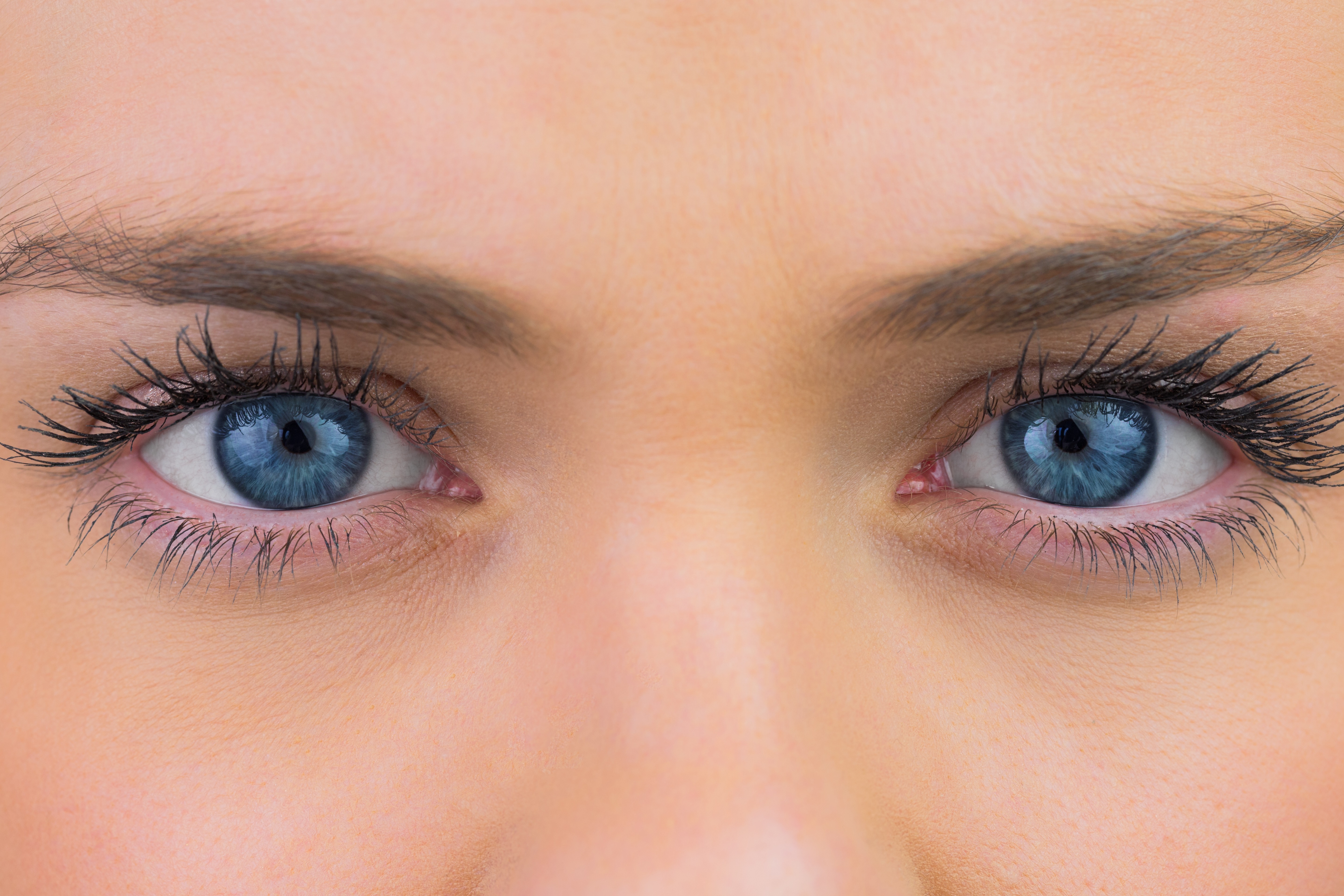Updated on October 1, 2024
Why Are Blue Eyes Blue?


Vision Center is funded by our readers. We may earn commissions if you purchase something via one of our links.
Blue eyes have fascinated people for centuries. In cultures around the world, they’re seen as beautiful yet also cold. This may be because blue eyes are rare, making up just 8-10% of the world’s population.7
This article discusses why some eyes are blue, interesting facts about blue eyes, and how the color of your eyes can affect your health.
What Causes Blue Eyes?
Scientists believe blue eyes result from a genetic mutation that reduces melanin production in the iris.
Just like your skin and hair, how much melanin you have determines your eye color. Eyes with less melanin appear to be lighter colors like green or blue.
All eyes are technically brown because melanin itself is brown. People with more melanin tend to have brown eyes, the most common eye color. Those with lighter eyes tend to have less melanin.
This has to do with how light interacts with melanin in the iris. When light hits the iris, melanin causes it to split into various colors on the spectrum.
Are Blue Eyes Really Blue?
Blue eyes don’t contain blue pigment, so it’s fair to say they aren’t really blue. They simply appear blue because the lack of melanin causes light to split into a color spectrum. This effect is known as Rayleigh scattering.
There is no actual blue pigment for eyes. People with brown eyes have them because melanin is a brown pigment.
The result of this scattering of light is blue light hitting the top of the iris. This gives the eyes their blue appearance.
What Determines Eye Color?
Blue eye color was previously believed to be a Mendelian recessive trait, with brown eyes being dominant.
Now, scientists know that eye color is determined by the interaction of many genes. This makes it impossible to predict the color of a baby’s eyes, even if both parents’ eyes are blue.
The Role of the Iris in Eye Color
Human eye color depends on the makeup of the iris, which is the colored part of the eye. The iris has two layers. The back layer (pigment epithelium) contains brown pigment, even in blue-eyed people.
The front layer (stroma) can make eyes appear blue, brown, hazel, or green:
- Blue eyes. Have no pigment in the front layer, causing more blue light to reflect back out.
- Green or hazel eyes. Have light brown pigment in one or both layers of the iris. This mix of light brown pigment and blue light makes eyes appear green or speckled.
- Brown eyes. Have brown pigment.
Does Having Blue Eyes Affect Your Health?
Research shows that human eye color may influence various aspects of health and well-being.
Advantages of Blue Eyes
Blue-eyed people have a lower risk of developing cataracts.
A cataract occurs when the normally clear lens of the eye becomes cloudy. This common eye condition can cause blurry vision and poor night vision.
Disadvantages of Blue Eyes
Blue-eyed people may be at greater risk for some health problems than brown-eyed individuals. These include:
Type 1 Diabetes
According to some Italian researchers, blue eyes may be a risk factor for Type 1 Diabetes.1 Although more research is needed to understand this connection fully, it’s important to keep it in mind.
Eye Cancer
Blue-eyed people are also more susceptible to eye melanoma, also known as ocular melanoma. This is cancer of a layer of the eye called the uvea.
Complications from eye melanoma include glaucoma and vision loss. Cancer can also spread to the liver, lungs, and bones.
8 Interesting Facts About Blue Eyes
Here are eight interesting facts about blue eyes:
1. The Genetic Mutation Stems from Common Ancestry
Genetics determine eye color. Of the at least 16 genes associated with eye color, one of them, the OCA2, is important for producing melanin.
Scientists believe the genetic mutation that causes blue eye color first occurred in a single human from the Black Sea region of Europe between 6,000-10,000 years ago. This makes all blue-eyed people (very) distant relatives.2
2. They Have Better Night Vision
The lack of melanin in blue eyes allows more light to pass through. As a result, blue-eyed individuals are somewhat better at seeing at night than people with darker eyes.
3. More Sensitive to Light
By the same token, people with blue eyes find it challenging to adjust to bright sunlight. This condition is known as photophobia. It’s relatively harmless, but it makes bright days a bit more uncomfortable. Wearing sunglasses can help.
4. They’re Considered More Desirable
According to a poll from 1800Contacts, most respondents rated blue as the color they’d most like their romantic partner’s eyes to have. And 47.6% of people said they wish they had blue eyes themselves.4
5. Most Common in Europe
Blue eyes are most common in people of European descent, mainly from Western Europe and Scandinavia. Particular countries with high percentages of blue-eyed individuals include:7
- Estonia (89%)
- Finland (89%)
- Sweden (78%)
- Iceland (75.5%)
6. Most Likely to Succeed
Humans’ fascination with eye color extends beyond romantic interest. 31 of the last 46 U.S. presidents (67%) have had blue eyes.3
Of all eye colors, those with blue eyes reported getting a raise or promotion at work, according to a poll.
7. Less Sensitive to Pain
A study of pregnant women found that those with lighter eyes experienced less pain than darker-eyed women. They also had fewer issues with sleep, anxiety, and depression.6
What Blue Eyes Look Like (Pictures)


Summary
Blue eye color results from a genetic mutation that reduces melanin production in the iris. There’s no blue pigmentation, but the lack of melanin causes blue light to reflect from the eyes.
Contrary to previous beliefs, blue eyes aren’t a recessive trait. Many genes contribute to eye color, so you can’t predict what color a baby’s eyes will be.
People with blue eyes may be at greater risk for certain health problems, such as eye cancer. However, their risk for cataracts is lower than that of people with brown eyes.
In this article
7 sources cited
Updated on October 1, 2024
Updated on October 1, 2024
About Our Contributors
Vincent Ayaga is a medical researcher and seasoned content writer with a bachelor's degree in Medical Microbiology. Specializing in disease investigation, prevention, and control, Vincent is dedicated to raising awareness about visual problems and the latest evidence-based solutions in ophthalmology. He strongly believes in the transformative power of ophthalmic education through research to inform and educate those seeking knowledge in eye health.
Dr. Melody Huang is an optometrist and freelance health writer with a passion for educating people about eye health. With her unique blend of clinical expertise and writing skills, Dr. Huang seeks to guide individuals towards healthier and happier lives. Her interests extend to Eastern medicine and integrative healthcare approaches. Outside of work, she enjoys exploring new skincare products, experimenting with food recipes, and spending time with her adopted cats.

